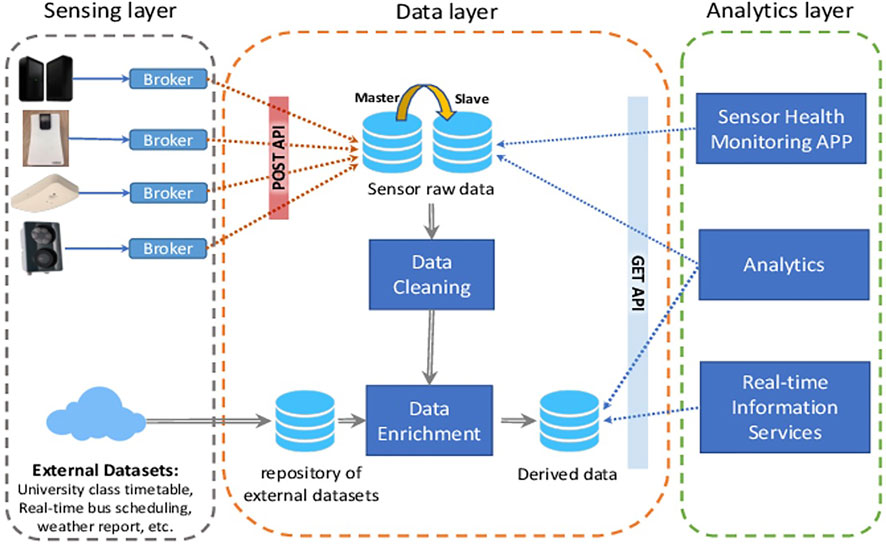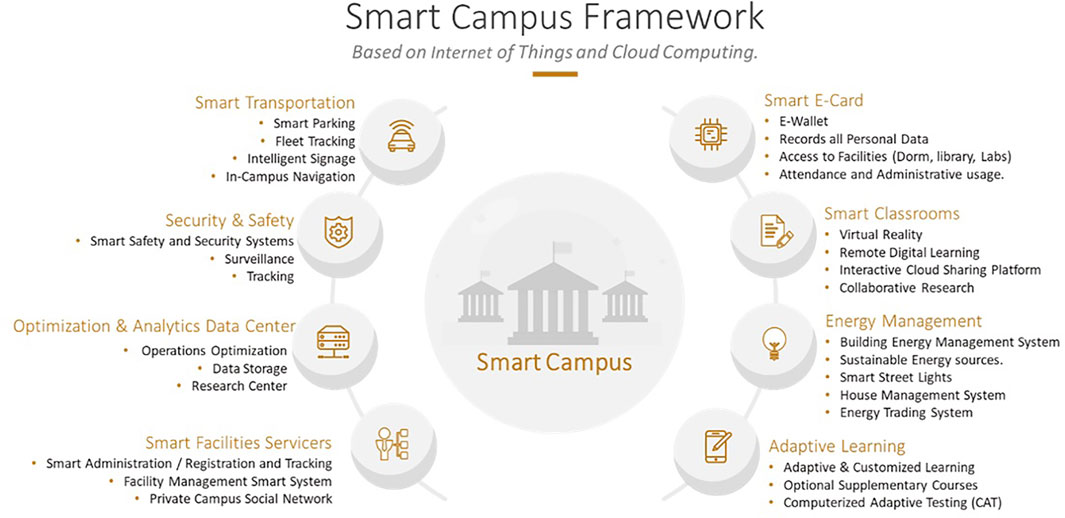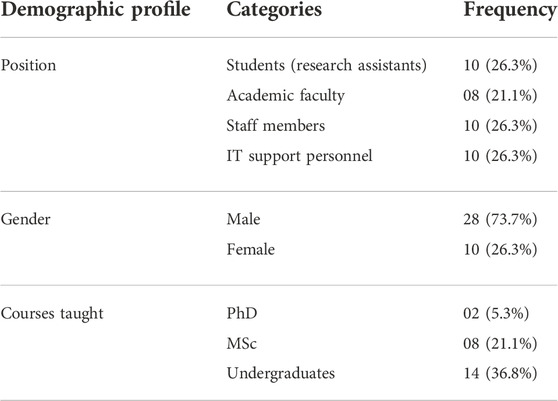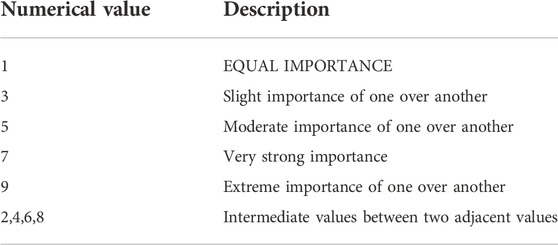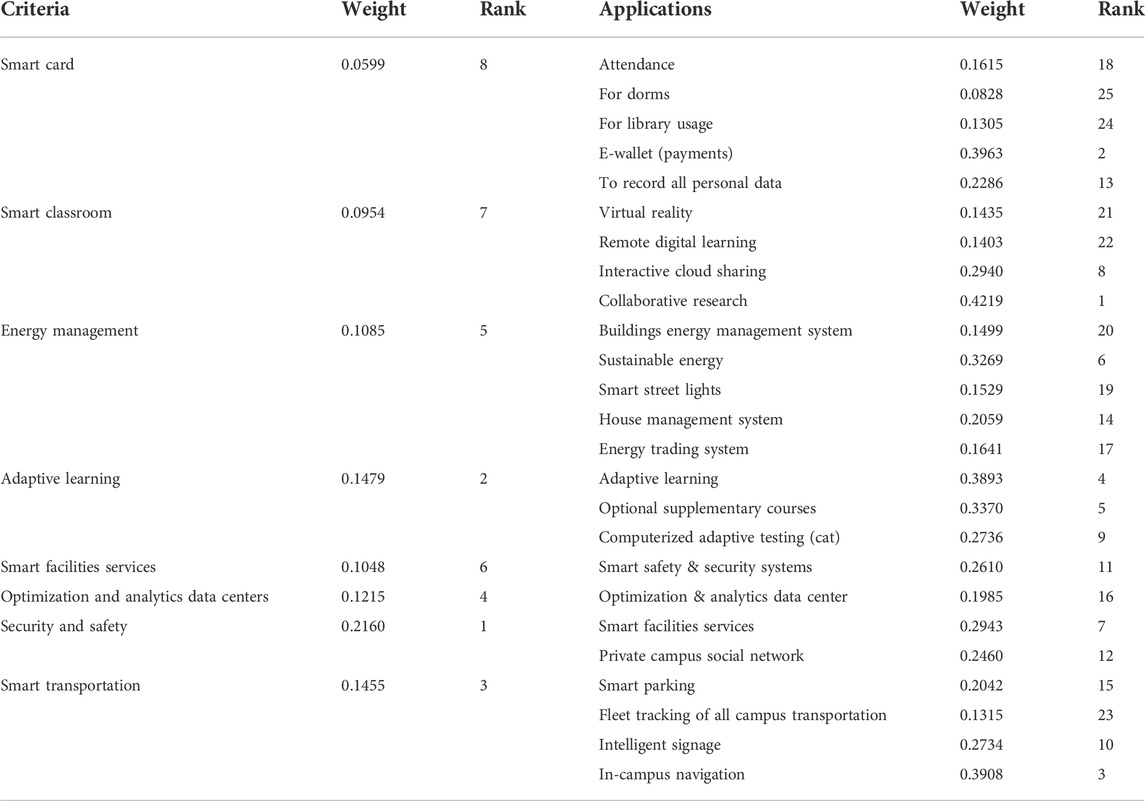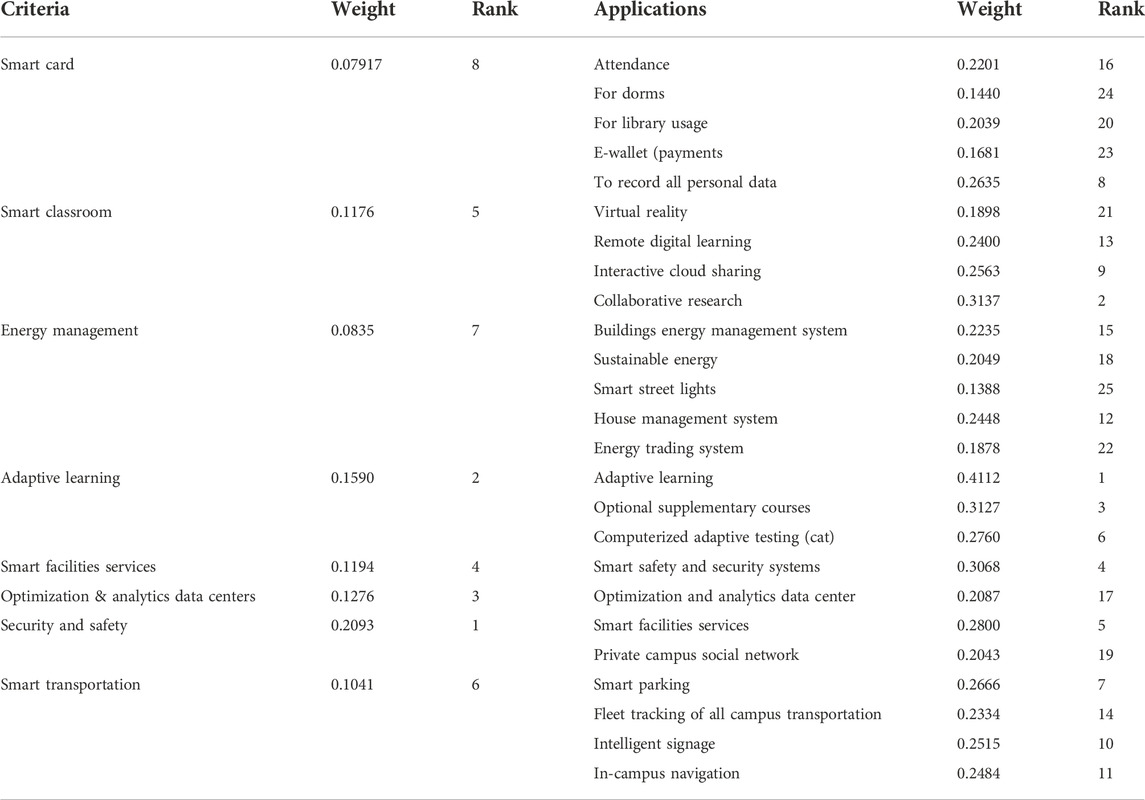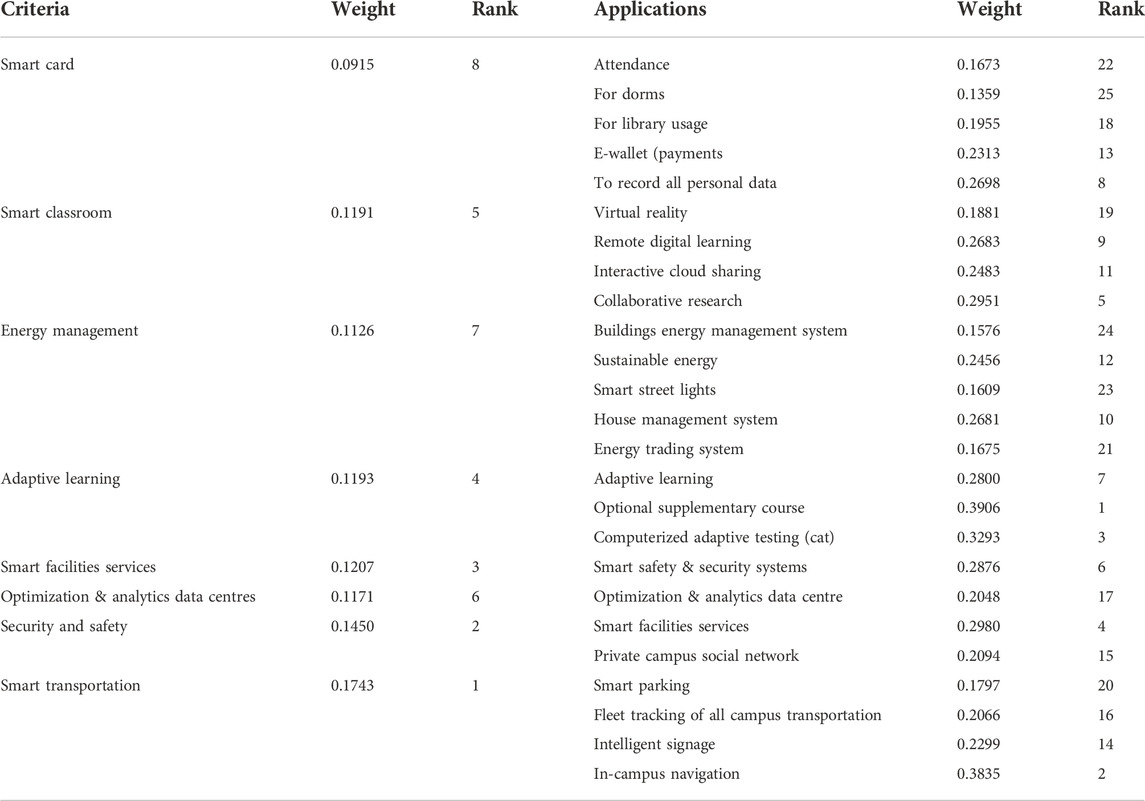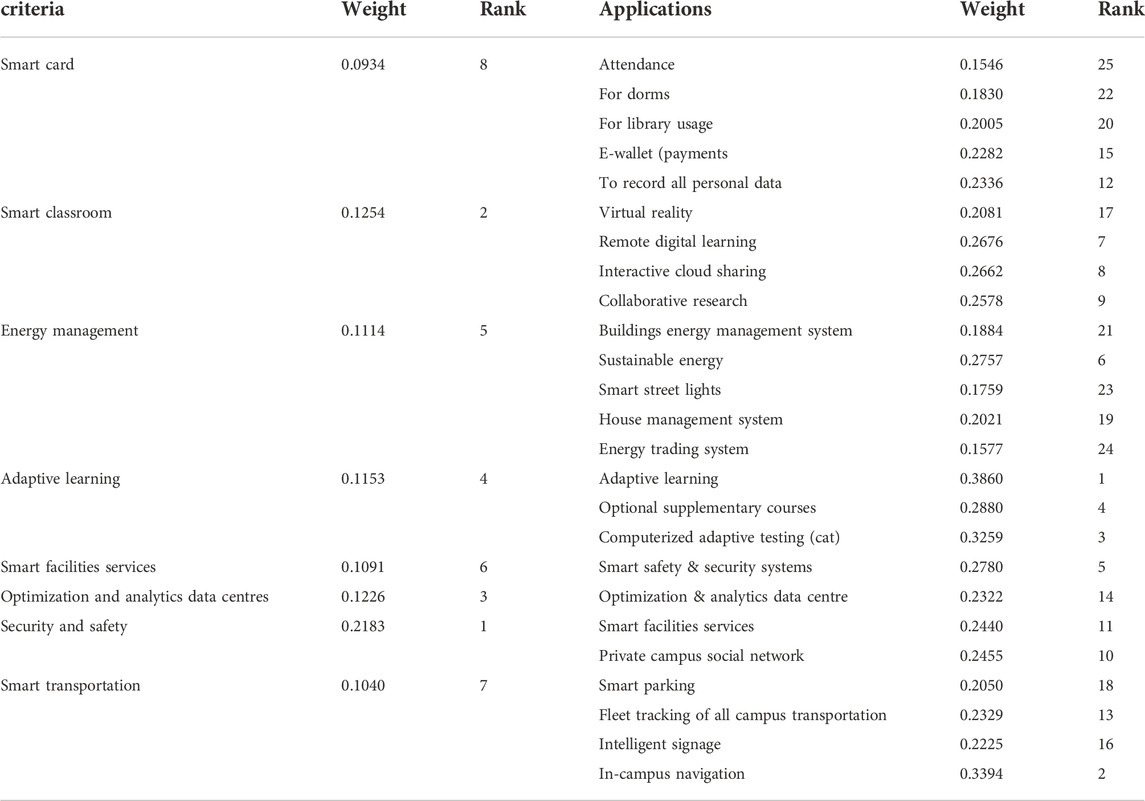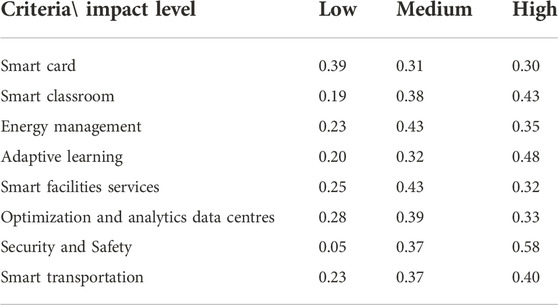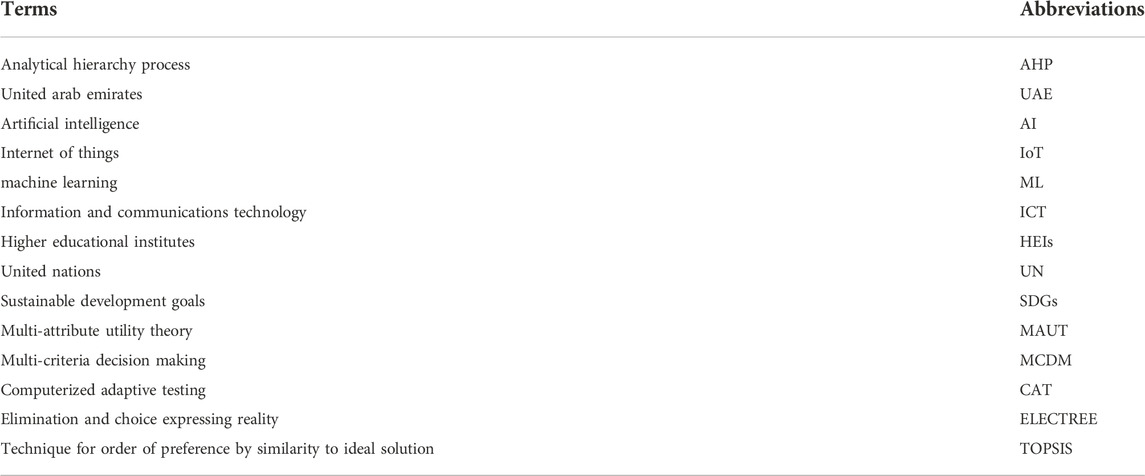- 1College of Engineering, American University of Sharjah, Sharjah, United Arab Emirates
- 2School of Business Administration, American University of Sharjah, Sharjah, United Arab Emirates
- 3American University of Sharjah, Sharjah, United Arab Emirates
The advancement in technologies in the education sector has improved living standards and acts as a sustaining factor for future development. Recently, the integration of technologies into the campus to transform it into a Smart Campus has experienced exponential growth in interest from researchers. Though various definitions of the concept of ‘Smart Campus’ have been proposed, the integration of the end users’ perception is always lacking in the concept. This study, therefore, intends to build on the theory to classify the most significant criteria that underpin the ‘Smart Campus’ by considering the institute’s stakeholders’ perceptions. A multi-step methodological approach is adopted to develop a decision support tool that allows the decision makers to invest in the optimum solution to transform a traditional campus into a smart campus. The study initially looks into the criteria and sub-criteria from the literature that defines a ‘Smart Campus’. Secondly, a survey was conducted by targeting a sample of students, faculty, administrative staff, and IT support personnel from a leading institute in the UAE region as a single case study. Thirdly, an AHP analysis was performed among different stakeholders. The findings suggested that there exists a consensus among the perception of a diverse group of participants who perceive smart security and safety, campus navigation, and adaptive learning as the most important criteria and applications to transform the traditional campus into a smart campus. Finally, the decision support tool development on the Utility function model allows the decision makers, i.e., Network Managers, IT Managers, Systems and Cloud Managers, and Senior Managers from the Finance departments, to make informed and strategic decisions in terms of the optimum solution for the transformation from a traditional campus to a smart campus.
1 Background
Since the 20th century, the internet has progressively served as a fundamental pillar of the modern information city and the society within. Today, most developed countries are capable of offering unlimited access to the Internet; an advantage that is becoming more common than before. As of April 2022, a global digital population of 5 billion internet users worldwide and 4.65 billion social media users have been reported (Internet users in the world 2022, 2022). Throughout this digital expansion, the introduction of contemporary technologies such as Artificial Intelligence (AI), the Internet of Things (IoT), and Machine Learning (ML) redefined the standards for urbanization and created the need for new urban planning strategies. These methods often involve conceptual projects which integrate information technologies to solve urban problems, now known as ‘Smart Cities.”
The term was first coined in Dutton, Blumler, and Kraemer’s book ‘Wired Cities: Shaping the Future of Communications’ published in 1987. The authors envisioned revolutionary environments where digital advancements provided ICT services to businesses and homes and called them “Wired Cities.” Likewise, many scholars adopted the same concept but differed in the term used. Kitchin. (2013) highlighted similar works defining “Smart Cities”; following Dutton et al. (1987), Graham and Marvin in 1999 used the term “Cyber Cities,” Ishida and Isbister in 2000 used “Digital Cities,” Komninos in 2002 used “Intelligent Cities,” Hollands in 2008 used “Smart Cities,” and finally, Shepard in 2011 used “Sentient Cities”. Each of these terms defined a unique relationship between information technology and urban development. Recently, these labels were subsumed under the term “Smart Cities,” a term which has gained traction in business and government, as well as in academia (Kitchin, 2013).
Although the establishment of a smart city is expected to be extremely costly and large-scale, multiple studies have directed their focus toward the implementation of a “Smart Campus.” Min-Allah and Alrashed. (2020) highlighted a case study that was presented to the World Bank in 2014 by the University of Lille regarding the smart city and advocated the “Smart Campus” as an initial step towards the realization of the concept of a smart city. Likewise, Omotaya et al. (2021) concluded in their study that “smart campuses could act as living labs for future smartness of cities globally.” Similarly, Ahmed et al. (2020) underlined how the most significant sector in the development of any society and city is its education system, making it pertinent to incorporate recent technologies into current educational institutes in order to transform them into smart campuses.
The timeliness and promising results provided by the smart cities concept have led many researchers and scholars to pursue smart campuses within their architecture and framework. A strong correlation between the mobilization of educational resources and urbanism is recognized through these studies, suggesting the establishment of an educational facility that encompasses sustainable digital technologies. The said facilities are known by the title ‘Smart Campus’ and their exact representations may vary according to every institution.
Literature reports from a number of countries and research institutes have directed their studies toward promoting smart cities and sustainable development. According to Camargo et al. (2021) Malta formulated the “Smart Island Strategy” between the years 2008 and 2010, followed by the United Kingdom, which announced “Unlocking Growth in Cities” in 2011, and Spain with its project “National Plan for Smart Cities” in 2015 (Millard et al., 2014). Whereas in 2017, countries such as the United States, Germany, and Hong Kong announced their smart city schemes under the titles of “Smart Cities and Communities Federal Strategic Plan: Exploring Innovation Together.” “Smart Cities Charter” and “Smart City Blueprin,t” respectively (Camargo et al., 2021).
Similar to all the other developed countries above, the United Arab Emirates (UAE) soon gained popularity as an incubator for smart cities’ applications, seeking to present Dubai as the first smart city in the world (Vinod Kumar, 2020), while recently launching an initiative named ‘Smart Dubai 2021’ (Smart Dubai 2021, 2018).
There still is no comprehensive statement that clearly defines a smart campus, however, efforts have been made to interpret certain aspects of it. It has been highlighted that research primarily focuses on identifying the factors that can be used to define the term “Smart Campus” and identify its sophisticated infrastructure. However, no studies have been conducted regarding the end users’ perspectives on the factors they think are necessary for their respective campuses. As such, the literature does not report on any utility functions that help identify smart campus criteria for academic institutions. Hence, the absence of a decision support tool is the primary motivation behind this study.
Thus, the UAE is one of the leading countries in relation to the development of smart cities and has acted towards a smart and sustainable agenda. Nonetheless, the existence of a well-established smart campus within the UAE remains theoretical. This study, therefore, uses the American University of Sharjah as a case study to upgrade educational institutions. The study intends to determine the perception of different end users such as students, faculty members, administrative staff, and IT personnel regarding the most significant criteria of a smart campus.
Moreover, utility functions will be adopted to propose a decision support tool that aids the decision-making process in order to prioritize the different stakeholders’ perceptions of the most important criteria that can be considered for transforming a traditional campus into a smart campus.
2 Literature review
Literature reports on several studies that have directed their inquiries toward smart cities. These definitions have shifted their focus from the “Internet” as being the “smart city” identifier’ in the 1990s, to a wider context that encompasses socio-economical as well as technical factors. Ramirez (2017) in her study emphasizes that despite the lack of a universal definition for what constitutes “smart cities,” cities that aspire to this designation aim to fully utilize all technological advancements to cut costs, improve efficiency, offer new services, lessen their environmental impact, and foster innovation (Aguaded-Ramírez, 2017). Similarly, Caragliu et al. (2011) identified a city to be smart when “investments in human and social capital and traditional (transport) and modern (ICT) communication infrastructure fuel sustainable economic growth and a high quality of life, with a wise management of natural resources, through participatory governance.” BSI Standards Publication. (2014) considered smart cities to include an effective integration of physical, digital, and human systems in the built environment to deliver a sustainable, prosperous, and inclusive future for its citizens. Moreover, the European Parliament. (2014) described a smart city as “a city seeking to address public issues via ICT-based solutions on the basis of a multi-stakeholder, municipally based partnership.” These illustrations highly reflect the integrative nature of a smart city to serve societies and improve their levels of prosperity.
Among the key forces driving technology growth in the twenty-first century is the sustainability agenda, and in order to accomplish particular objectives, governments, practitioners, society, and educators must react to these advancements. Through leaner processes and more responsive environments, smart technologies have taken over the world with their smart applications to improve quality of life. While such a significant digital transformation cannot happen overnight due to its cost implications and the complexity of the processes involved, a gradual transformation would be viable.
The primary objective of sustainable development is to promote economic and social development without compromising the environment. Batagan. (2011) conducted a study on smart cities in 2011 and highlighted that city sustainability is a multidimensional concept that incorporates economic, social, and political dimensions. Batagan. (2011) also identified three urgent goals for the concept of sustainable development: a development goal that focused on enhancing quality of life, a sustainability goal of living sustainably, and goals related to investing in technological advancement and innovation.
On the other hand, educational institutes are also expected to contribute their portion in fulfilling the United Nations (UN) Sustainable Development Goals (SDGs). The three main pillars of sustainability include facilitating economic viability, environmental protection, and social equity. Higher Educational Institutes (HEIs) are mentioned specifically under the fourth SDG, which ensures inclusive and equitable quality education while also promoting lifelong learning opportunities for all. HEIs could also contribute to the remaining SDGs through teaching, research output as well as campus initiatives, such as implementing green smart campus solutions (Moraes et al., 2020).
Thus, it is essential to understand the crucial difference between traditional and smart campuses. Where (Yi et al., 2021) highlighted the major difference exists in the modes of learning with traditional campuses entirely dependent on a synchronous mode of learning (limited to real-time interaction among the instructors and students) in contrast with the asynchronous mode of learning offered by the smart campus that allows the students to access materials on their own pace and allow unlimited interaction. The benefit of a smart campus is not only limited to the mode of learning but offers an interconnected environment of multiple features around the campus.
The rest of this section, therefore, looks to gain a deeper understanding of smart campus concepts and definitions, identifying the criteria that underpin the formation of a smart campus while proposing a suitable approach for developing a Multi-Attribute Utility Function that will help develop a smart campus decision support tool.
2.1 Smart campus
A review was recently published in April 2022 which revises the technology adoption factors for IoT-based smart campuses, and it lists the efforts that have been made regarding this topic (Sneesl et al., 2022). These efforts include a knowledge management model for smart campuses, which was conducted in Indonesia (Hidayat and Sensuse, 2022), a study on the key performance indicators for smart campuses and microgrids (Alrashed, 2020), and another study regarding an IoT-based hybrid renewable energy system for smart campuses (Eltamaly et al., 2021). The review also highlighted a methodology proposal for smart campuses (Pupiales-Chuquin et al., 2021), as well as a roadmap to smart campuses based on the IoT (Pandey et al., 2020).
Furthermore, a study on a smart campus using the Internet of Things (IoT) highlighted that the main concept of a smart campus is to develop premises that utilize resources efficiently and deliver high-quality services to the campus community while minimizing operational costs (Alghamdi and Shetty, 2016). It also elaborated on the benefits of establishing a smart campus, which included providing an interactive and creative environment for students and faculty, promoting smart energy management, bringing effective surveillance systems and real-time incidents warnings, automating maintenance and business processes, maintaining efficient parking and access control management, and providing secure payments and transparent voting systems (Alghamdi and Shetty, 2016).
A general outlook on what could be used to define a ‘smart campus’ remains necessary. Carames and Lamas (2019) highlighted in their study that the concept of a smart campus refers to the hardware and software required to provide advanced intelligent context-aware services and applications to different stakeholders. Martins et al. (2021) described a smart campus as one where equipment and devices, apps, and people are securely connected to provide new experiences and utilities and to enhance operational effectiveness and efficiency. Petcovici and Stroulia. (2016) defined a smart campus as one where physical and virtual spaces interact through the use of intelligent devices. Likewise, Dong et al. (2020) described it as “an educational environment that is penetrated with enabling technologies for smart services to enhance educational performance while meeting stakeholders’ interests, with broad interactions with other interdisciplinary domains in the smart city context.”
These definitions indicate that the existence of a sophisticated infrastructure remains critical, and there is a need to search for and define the infrastructure on which smart campuses can operate. Moreover, despite the basic construction of campus network infrastructure being completed, Guo and Zhang. (2015) argue that traditional construction cannot meet the development of campus scientific decisions and teaching Informa ionization. However, recent technological advancements coupled with advances in data analytics tools and platforms present opportunities to transform campuses in new ways, prompting many universities worldwide to develop strategies for a smart campus (Guo and Zhang, 2015). Furthermore, the authors (2015) highlight that in order to achieve dynamic expansion, resource adaptation, sizing deployment, and united management of a virtual data center, IoT must be incorporated into existing facilities, as well as cloud and virtualization technologies.
As such, the literature contains multiple studies that propose IoT and cloud computing as the primary foundations of smart campuses. IoT is simply a system of interrelated computing devices that are integrated with unique identifications that enable sending and receiving data over a network. The potential benefits of implementing IoT technology in smart campuses mostly revolve around three elements (Dong et al., 2020). First, it offers educators the information platform they need to monitor students’ progress and make wise decisions. Second, IoT automates smart campus operations and streamlines the teaching and learning process. Third, students’ ability in their learning activities can be tracked via IoT-based emotion or psychological recognition, and appropriate action can be taken (Dong et al., 2020). Moreover, cloud computing uses network servers on the Internet to store and manage data rather than local servers or computers. Cloud computing could be regarded as a development of distributed computing, parallel computing, and grid computing (Guo and Zhang, 2015). Through it, massive, highly virtualized computing and storage resources are combined into one large resource pool that can be utilized to deliver unified services (Guo and Zhang, 2015).
Similarly, Sutjarittham et al. (2018) proposed an overall architecture of a smart campus that accommodates use cases such as classroom attendance, student study space usage, parking lot occupancy, and bus-stop wait times. The primary goal of the system architecture, according to the study’s authors, is to support the collection of data produced by various smart sensing devices and its retrieval for use by applications (Sutjarittham et al., 2018) as shown in Figure 1. Figure 1 illustrates a high-level system architecture that depicts how data moves from sensors in the sensing layer to applications in the analytics layer.
This architecture was divided into three layers: A sensing layer, a data layer, and an analytics layer. The sensing layer incorporates arbitrary sensors and IoT technologies–connected devices with heterogeneous power and communications requirements into the system, the data layer stores the collected sensor values, and lastly, the analytics layer transforms sensing data into insights and actionable intelligence for applications use, enabling various services offered in a smart campus (Sutjarittham et al., 2018).
Similarly, a study by Ahmed et al. (2020) identified a set of comprehensive criteria for a smart campus, which was evaluated as to whether they formed part of a smart campus and evaluated these criteria from the stakeholders’ perception, using the American University of Sharjah as a case study. The study proposed a conceptual framework for a smart campus that underpins the most important criteria from the end users’ perspective. As part of their proposed framework, the criteria included applications that offered seamless and connected environments backed by the Internet of Things (IoT), cloud computing, and big data analytics (Ahmed et al., 2020).
The unified framework for smart campus consisted of 8 main and 25 application-based criteria on IoT and Cloud computing platforms (Ahmed et al., 2020). The proposed comprehensive framework is shown in Figure 2.
This paper builds on this study by using the identified criteria such as;
2.1.1 Smart Card
A smart card can be considered a minicomputer that uses a microprocessor chip to store and process data. The smart card makes it possible to access amenities on a smart campus quickly, easily, and securely.
2.1.2 Smart classroom
A smart classroom can be seen as a technology that bridges the gap between tele-education and traditional classroom settings. The idea of a smart classroom is built on contemporary technologies like 3G, 4G, the Internet of Things (IoT) platform, and other technologies to create a linked and coordinated environment (Fernández-Caramés and Fraga-Lamas, 2019).
2.1.3 Energy management
A system that plans and integrates power usage with nearby renewable energy sources and battery banks. It allows for storing and transferring data, which can be utilized as a data center to forecast energy output and consumption. It is a significant concept that relates to the Sustainable Development Goals to ensure clean energy and thus should be addressed in transforming from a traditional campus to a smart campus.
2.1.4 Adaptive learning
Adaptive learning is considered an educational approach based on a computerized algorithm that allows for customizing the educational strategy or learning environment in accordance with an individual’s demands.
2.1.5 Smart transportation
An essential aspect of facilities management is parking and fleet management. The criteria include logistics optimization, informative and quick notifications, and allows for better mobility.
2.1.6 Security and safety
The criteria rely on the idea of root cause analysis (RCA), which is a methodical way to discover the “root cause” of a problem and prevent it from occurring in the future, and the security and safety standards help with advanced protection.
2.1.7 Optimization and analytics data center
A vital part of any facility is the optimization and analytics data center. Consequently, the smart campus framework must address this essential criterion. The criteria support classification, data lakes, and current upgrades.
2.1.8 Smart facilities and services
Dynamic campus life, responsive buildings, and easy access to athletic fields, student centers, libraries, and restaurants are all provided for stakeholders by the smart facilities services.
The study adopts the multi-criteria approach to develop a utility function that aids in the decision-making process while prioritizing the stakeholders’ perceptions of the most important elements of transforming a traditional campus into a smart campus.
2.2 Multi-Attribute Utility Function
Multi-Attribute Utility Theory (MAUT) is the most popular Multi-Criteria Decision Making (MCDM) technique. The MAUT, which is an extension of Multi-Attribute Value Theory (MAVT), is known as the most rigorous approach to include risk preferences and uncertainty in multi-criteria decision-support strategies. The MAUT approach integrates expected utility theory to determine the best and optimum solution in a given scenario by allocating a utility to each possible attribute and measuring the best possible utility (Orsborn et al., 2009).
Over the years, several studies have adopted MAUT to support decision analysis in practical settings, for example, Orsborn et al. (2009) adopted the utility function to estimate customer preferences over the aesthetic space. The study integrates the customer preference of the attributes in the utility function to determine the higher utility product for form generation and modification or design verification.
Moreover, Torrance et al. (1996) adopted a multi-attribute preference-based utility function to assess the health-related quality of life by integrating seven attributes such as sensation, mobility, emotion, cognition, self-care, pain, and fertility. The Health Utilities Index adopted a standard gamble technique to measure the utilities.
Likewise, the study by Abolbashari et al. (2018) developed a model based on the utility function for procurement performance management by adopting a case study. The decision model allows the decision makers to determine the optimum Key Performance Indicators (KPIs) to invest in that have an impact on procurement performance. The findings of the study indicate that the optimum solution for the organization is to invest and allocate its resources to staff training and procurement cycle time to achieve the highest utility.
Another application of the utility function was identified by Walsh et al. (2004). The study adopted the utility function for autonomic resource allocation among multiple applications. For the estimation of the utilities, the study adopted and compared two methodologies based on the queuing-theoretic performance model and model-free reinforcement learning. Furthermore, to overcome the issue of outsourcing contracts for vendor selection, the study by Teixeira de Almeida. (2007) adopted the utility function and ELECTREE function to propose a model that integrates multicriteria evaluation. The study illustrates the effectiveness of the model through a case study. Furthermore, the utility function was presented in the study by Jæger. (2007), which intended to determine the utility of both economic and social returns to education. The findings of the study concluded that economic returns to education are somewhat more important than social returns.
Thus, this indicates the effectiveness of adopting the utility function to determine an individual’s preferences based on multiple attributes and criteria. The utility function allows us to determine the rational choice theory to analyze human behavior and preferences. Besides, the major benefit of adopting MAUT is that it considers the uncertainty, which is not accounted for in many MCDM methods.
From the literature, it can therefore be summarized that the definition of the smart campus can be underpinned by several criteria while the importance of each criterion and/or sub-criterion vary according to every institution. Thus, these can be used to address the research question of which factors are perceived to be important by the end user and demonstrate how MAUT can be adopted to develop a decision support tool that can aid the decision maker to make informed decisions.
This study, therefore, intends to adopt the AHP and utility function by integrating the multiple criteria of a smart campus to determine the optimum criteria/solution to invest in to transform a traditional campus into a smart campus.
3 Methodological steps
This section presents the following methodological steps adopted to achieve the aim of the study which is to develop a decision support tool that allows the decision-makers to invest in the optimum solution to transform a traditional campus into a smart campus.
3.1 Stage I literature review
This stage helped understand “Smart Cities and Smart Campuses” and identifies the underpinning criteria that define a smart campus in order to adopt the best solution to develop decision support tool that can be adopted by the decision-makers to help identify the most important criteria for the transformation of a traditional campus into a smart campus.
3.2 Stage II surveys
A survey is conducted targeting a sample of students, faculty, administrative staff, and IT support personnel from across the university to evaluate their perceptions of the most significant criteria of a smart campus in AUS, using AHP analysis based on pairwise comparisons to compare the perception of students, faculty, and administrative staff.
3.3 Stage III decision support tool
This stage helps with developing the decision support tool based on the utility function. The stage allows the decision-makers (university administrators) to rank the smart campus criteria based on their level of impact and their importance in transforming a traditional campus into a smart campus. In addition, the decision-makers will be asked to rank each criterion on a scale from -10 to 10, this allows us to determine the acquired utility and the optimum decision or criteria to invest.
4 Data collection and analysis
This section presents the data collection methods and analysis adopted to develop a decision support tool that allows the decision-makers to determine the optimum decision or criteria to invest in transforming a traditional campus into a smart campus.
4.1 Case study
The study targets the American University of Sharjah as a case study due to its forward-looking approach that endeavors to continuously move with the times and keep up with current developments as well as respond to market needs through the provision of excellent student services and environment. The university is a leading institute in the region with the reputation of being a research hub. The current research projects by the institute such as developing a virtual charging system for electric vehicles, and the adoption of IoT and big data to support UAE-wide smart city initiatives, shows the commitment and role of the institute in the development of smart cities, in general, and the smart campus, particularly.
4.2 Pre-development phase
The phase includes a survey, which was developed by adopting an analytical hierarchy process (AHP) to conduct a pairwise comparison among the 8 smart campus criteria and their corresponding 25 applications, as shown in Figure 2. The study adopted purposive sampling by targeting students, faculty, administrative staff, and IT support personnel, which the authors identified as being actively involved in research of the latest technologies and having sound knowledge of smart cities. The survey intended to identify the most important criteria based on the perceptions of a diverse group of end users to transform a traditional campus into a smart campus. The survey also drew upon a comparison among the different participant groups to determine which criteria and applications are important to each group. The intent of the comparison was to set a benchmark for the decision-makers to make decisions based on the perception of end users.
4.3 Participant’s profile
The survey was distributed to selected participants that have sound knowledge of the smart city and smart campus. A total of 38 participants were targeted as summarized in Table 1.
The survey participants included 10 students working in research assistant positions, 8 faculty members that taught Ph.D. MSc, and undergraduate courses, 10 staff members, and 10 IT support personnel that specializes in the latest technologies and had a sound knowledge of smart cities. To determine the perception of the participants belonging to different groups, an online survey was sent to the selected participants. The survey asked the participants to pairwise rank the 8 criteria and 25 applications using a Saaty scale as shown in Table 2.
The findings of the survey were presented in the table below:
4.4 Students
The survey response accumulated from the students’ participants were shown in Table 3. The findings suggested that smart security and safety, followed by adaptive learning, were the preferred criteria that the students perceived to be suitable for the transformation of a traditional campus into a smart campus.
Moreover, the most important application perceived by the students to transform the campus into a smart campus was collaborative research, e-wallet payment, and in-campus navigation.
4.5 Staff members
Furthermore, the survey was sent to selected members of staff who are involved in dealing with smart technologies. The survey findings suggested that both, the students, and the staff members perceived smart security and safety followed by adaptive learning as the most important criteria for transformation into a smart campus, as shown in Table 4.
Furthermore, the applications perceived to be important to the staff members were adaptive learning, collaborative research, and optional supplementary courses.
4.6 Academic faculty
Moreover, the survey also targeted academic faculty that taught Ph.D. MSc, and undergraduate courses related to smart cities and big data. The findings of the survey in Table 5, show that the faculty perceive that smart transportation, followed by smart security and safety, were the most significant criteria to transform a traditional campus into a smart campus.
Whereas, for the applications, the faculty perceived optional supplementary courses, computerized adaptive testing (CAT), and in–campus navigation to be the most significant to invest in. Table 6.
4.7 IT support personnel
Finally, the survey targeted IT Support personnel that play a key role in transforming the institute into a smart campus. The findings suggested that the IT personnel perceived the adoption of smart classrooms and smart security and safety as the most important criteria to transform a traditional campus into a smart campus.
The applications deemed important by the IT department were adaptive learning, computerized adaptive testing (CAT) and in–campus Navigation.
To conclude, there existed a consensus among the perception of a diverse group of participants who perceived smart security and safety, in–campus navigation, and adaptive learning as the most important criteria and applications to transform a traditional campus into a smart campus. However, there also existed a difference in the perception of the importance of criteria such as smart transportation, smart classroom, and applications such as computerized adaptive testing (CAT) and optional supplementary courses. But it can be suggested that the criteria and applications relate to the scope of the group due to which they perceived it to be important.
The findings from the survey can be adopted as a benchmark and reference for the decision-makers to make decisions that transform a traditional campus into a smart campus.
4.8 Development phase
This phase targets Network Managers, IT Managers, Systems and Cloud Managers, and Senior Managers from the Finance departments as the decision-makers. The phase includes the following stages:
Stage I—Firstly, the decision-makers were presented with a survey to determine the level of impact of the criteria to transform a traditional campus into a smart campus. For this purpose, the participants were asked to rank the level of impact of each criterion based on a three Likert scale of level of impact such as Low, Medium, and High based on their expertise and perception. To determine the probability distribution, an equation of probability was adopted (Abolbashari et al., 2018):
For this scenario, j = 3 (Low, Medium, and High); i = 8 smart campus criteria, k = 1 (the study’s intent to determine the optimum solution to invest).
The total probability distribution of the response of the experts was then aggregated in a form of probability. This allows for the integration of the fuzzy nature of the criteria and its impact perception in the decision. The findings of the level of perceived impact of the criteria on transforming a traditional campus into a smart campus are shown in Table 7.
The results in Table 7 can be interpreted as 39%of the experts perceived a smart card has a low impact or plays an insignificant role in transforming a traditional campus into a smart campus, while 31% and 30% of the participants believed the criterion has a medium to high impact and role in transforming traditional campus to a smart campus. Furthermore, it can be seen that 58% of the participants perceived the impact level of smart security and safety as high to transform a traditional campus into a smart campus. The findings align with the findings of AHP analysis as conducted in the predevelopment stage.
Stage II—Secondly, to determine the optimum solution and criteria that the institution should invest in to transform a traditional campus into a smart campus, the decision-makers were asked to assign a utility to each criterion on a scale from −10 to 10. Each criterion utility is assigned a conditional probability distribution that depends on the influence node
The table shows the utility of each criterion against the impact factor of the criteria to transform a traditional campus into a smart campus.
Stage III—Finally, the expected utility for the decision for each criterion can be determined by adopting the utility equation as adopted by Abolbashari et al. (2018).
Here D, Decision node; U, Utility node; I, Influence node; i, number of criteria; j, number of states in criteria, k: to invest,
The equation calculates the expected utility of each criterion and allows us to determine the optimum solution and criteria to invest in to transform a traditional campus into a smart campus. The findings of the expected utility and optimum solution are presented in Table 9 below.
According to the results, from Table 9, the optimum decision to invest is smart security and safety followed by adaptive learning. The findings of the decision support tool also align with the perception of end users determine through AHP analysis in the predevelopment phase.
5 Discussions
The smart campus is an emerging trend that allows institutions to integrate smart technologies with their physical infrastructure to provide better services, decision-making, and campus sustainability, among other things. In recent years, an exponential interest in the features and implementation of these features with the latest technologies have been discussed in the literature to define a “Smart Campus” as mentioned in Table 10. However, with technological development on the rise, there is no single best definition or platform that denotes a smart campus. Thus, this is an emerging phenomenon that depends on multiple criteria and features.
A number of studies have proposed various platforms with multiple features and applications to transform a traditional campus into a smart campus such as cloud computing, the Internet of Things (IoT), Augmented reality (AR), and artificial intelligence to name a few as background platforms. These studies (Muhamad et al., 2017; Dong, et al., 2020; Min-Allah and Alrashed, 2020) also propose multiple human-centered and learning-centered features and applications, and environmental services including smart grid, learning environment, waste and water management, intelligent building, health and fitness, transportation, and smart parking.
These transformational applications were adopted by KFUPM by integrating ultrasonic sensing technologies and a database system that allows access control to dorms and assigns parking spots in the system to those living in dorms based on their preferences. In addition, this parking guidance system helps the students to park effectively (Alghamdi and Shetty, 2016).
Likewise, the Massachusetts Institute of Technology (MIT, Cambridge), in partnership with Microsoft, developed collaborative research with the goal of implementing an intelligent campus known as the MIT iCampus. The iCampus allows the end users to benefit from a class communicator system (CSS) and a class learning partner (CLP) to overcome the issues of miscommunication between instructors and students. The system offers an enhanced learning experience by offering instant feedback assessment and analysis (Alghamdi and Shetty, 2016).
Similarly, New York University (NYU) adopted the smart card to allow the stakeholders such as students, faculty, and staff to have a seamless experience around the campus. The card allows the end user to access the buildings, labs, and dorms. Moreover, the card acts as a debit card that can be used for payments for books, food, and other facilities around the campus. Thus, this shows the adoption of technologies allows for seamless and efficient management and experience (Alrashed, 2020).
However, where a number of these studies (Abuarqoub et al., 2017; Sánchez-Torres et al., 2018; Imbar et al., 2020) propose the latest technologies and features to build a smart campus, they fail to include the end user’s perception of what is important to their experience on a smart campus. This research, therefore, targets a diverse range of stakeholders by conducting a survey with a sample of students, faculty, administrative staff, and IT support personnel from the leading institute in the region as a single case study.
At the micro level, the findings suggested that smart security and safety, followed by adaptive learning, were the preferred criteria that the students perceived to be suitable for the transformation of a traditional campus to a smart campus. Moreover, the most important application perceived by the students to transform the campus into a smart campus was collaborative research, e-wallet payment, and in-campus navigation. Likewise, for the staff members, a similar perception was witnessed. The survey findings suggested that both the students and the staff members perceived smart security and safety, followed by adaptive learning, to be the most important criteria for transformation to a smart campus. Whereas the applications perceived to be important to the staff members were adaptive learning, collaborative research, and optional supplementary courses. Moreover, for the faculty, the findings suggested that the faculty perceived that smart transportation, followed by smart security and safety, were the most significant criteria to transform a traditional campus into a smart campus. Whereas, for the applications, the faculty perceived optional supplementary courses, computerized adaptive testing (CAT), and in–campus navigation to be the most significant to invest in. Finally, at the micro level for the IT personnel, the findings suggested that the IT personnel perceived the adoption of smart classrooms and smart security and safety as the most important criteria to transform a traditional campus into a smart campus.
Thus, at a macro level, it can be concluded that a consensus in the perception of a diverse group of participants was witnessed as they all perceived smart security and safety, in–campus navigation, and adaptive learning as the most important criteria and applications to transform a traditional campus into a smart campus. However, there also existed a difference in the perception of the importance of criteria such as smart transportation, smart classroom, and applications such as computerized adaptive testing (CAT) and optional supplementary courses. But it can be suggested that the perceived importance of criteria and applications is related to the scope of the group.
Secondly, the development phase for the decision support tool based on the Probability distribution and Utility Function, targeting the experts i.e., Network Managers, IT Managers, Systems and Cloud Managers, and Senior Managers from the Finance departments as the decision-makers to make informed and strategic decision in terms of the optimum solution for the transformation of a traditional campus into a smart campus, suggested that 30 percent of the experts thought the smart card would have a high impact and play a significant role in transforming traditional campus to a smart campus, where 43 percent thought smart classroom, 48 percent thought adaptive learning and the highest percentage of 58 percent of the experts and decision-makers thought smart security and safety would have the highest impact when it comes to transforming a traditional campus to a smart campus.
6 Conclusion and future work
The increasing importance of smart technologies has led cities to move faster towards implementing smart solutions to improve the living standards of individuals and the quality of their lives. Good education forms one of the most important factors to develop societies as it plays a vital role in building future generations and cultivating the way they think. Thus, this results in many universities and research institutes directing their studies toward smart cities and sustainable development. With United Arab Emirates (UAE), in general, and Dubai, in particular, being an incubator for smart cities’ applications with their initiative named “Smart Dubai 2021,” the development of smart campuses has gained popularity.
This study, therefore, lays the groundwork for institutions and decision-makers to make decisions by adopting a decision support tool based on the utility function that encompasses the most important criteria for promoting a smart campus, using AUS as a case study. The study identifies and compares the perception of diverse end-user groups such as students, administrative staff, academic faculty, and IT support personnel in terms of the most significant criteria for a smart campus. Finally, the tool allows the decision makers (university administrative staff) to make decisions by adopting DST to determine the optimum solution/criteria to invest in to transform a traditional campus into a smart campus. The limitation of the study, however, is the survey from a single institution in the United Arab Emirates region. Therefore, the findings are limited to end-user perception in the region. However, the tool proposed can be adopted by other researchers to implement a similar methodology. In addition, the scope of the study can be increased by taking into account multiple institutions within and outside the GCC and drawing on the comparison of the end user’s perception by adopting the TOPSIS method (Technique for Order of Preference by Similarity to Ideal Solution).
The findings of the study will allow the presentation of suitable sustainable practices that can enhance the sustainability rating of university campuses in the sociological, environmental, and economical aspects. This can further expand to positively affect the sustainability awareness inside cities and improve the living standards for individuals. The dissemination of the findings will open opportunities for further research and will attract researchers to study the multidisciplinary aspects of a smart campus to make a real impact through innovative research. Lastly, the findings will have a positive impact on the quality of education and socio-environmental preservations, as well as create pathways for future smart applications to take place on many other campuses and in future cities.
Data availability statement
The original contributions presented in the study are included in the article/Supplementary Material, further inquiries can be directed to the corresponding author.
Ethics statement
The studies involving human participants were reviewed and approved by Institutional Review Board, American University of Sharjah. The patients/participants provided their written informed consent to participate in this study.
Author contributions
All authors contributed to the study’s conception and design. Material preparation, data collection, and analysis were performed by VA, SS, NA, and MG. The first draft of the manuscript was written by SS and all authors commented on previous versions of the manuscript. All authors read and approved the final manuscript.
Funding
The research leading to these results received funding from the American University of Sharjah Faculty Grant under Grant Agreement No FRG21-S-E59.
Conflict of interest
The authors declare that the research was conducted in the absence of any commercial or financial relationships that could be construed as a potential conflict of interest
The handling editor declared a past co-authorship with the author VA.
Publisher’s note
All claims expressed in this article are solely those of the authors and do not necessarily represent those of their affiliated organizations, or those of the publisher, the editors and the reviewers. Any product that may be evaluated in this article, or claim that may be made by its manufacturer, is not guaranteed or endorsed by the publisher.
References
Abolbashari, M. H., Chang, E., and Hussain, O. K. (2018). “Performance management using Influence Diagrams: The case of improving procurement,” in Proceedings of the international conference on industrial engineering and operations management (Bandung, Indonesia: IEOM Society International).
Abuarqoub, A., Abusaimeh, H., Hammoudeh, M., Uliyan, D., Abu-Hashem, M. A., Murad, S., et al. (2017). “A survey on internet of things enabled smart campus applications,” in Proceedings of the international Conference on future Networks and distributed systems (Cambridge, United Kingdom: ICFNDS), 1–7.
Aguaded-Ramírez, E. (2017). Smart city and intercultural education. Procedia Soc. Behav. Sci. 237, 326–333. doi:10.1016/j.sbspro.2017.02.010
Ahmed, V., Abu Alnaaj, K., and Saboor, S. (2020). An investigation into stakeholders’ perception of smart campus criteria: The American university of Sharjah as a case study. Sustainability 12 (12), 5187. doi:10.3390/su12125187
Alghamdi, A., and Shetty, S. (2016). “Survey toward a smart campus using the internet of things,” in 2016 IEEE 4Th International Conference On Future Internet Of Things And Cloud (Ficloud), Vienna, Austria, 22-24 August 2016 (IEEE). doi:10.1109/ficloud.2016.41
Alrashed, S. (2020). Key performance indicators for smart campus and microgrid. Sustain. Cities Soc. 60, 102264. doi:10.1016/j.scs.2020.102264
Batagan, L. (2011). The role of open government data in urban areas development. Inform. Econ. 15 (3), 80–87. doi:10.12948/issn14531305/18.2.2014.08
BSI Standards Publication (2014). Smart city framework—guide to establishing strategies for smart cities and communities. B S I Standards. Available at: https://www.bsigroup.com/en-GB/smart-cities/Smart-Cities-Standards-and-Publication/PAS-181-smart-cities-framework/.
Camargo, F., Marín, C., and Crespo, R. (2021). Towards a new model of smart cities in emerging countries. Acad. Strategic Manag. 20 (6), 1–20.
Caragliu, A., Del Bo, C., and Nijkamp, P. (2011). Smart cities in europe. J. Urban Technol. 18 (2), 65–82. doi:10.1080/10630732.2011.601117
Dong, Z., Zhang, Y., Yip, C., Swift, S., and Beswick, K. (2020). Smart campus: Definition, framework, technologies, and services. IET Smart Cities 2 (1), 43–54. doi:10.1049/iet-smc.2019.0072
Eltamaly, A., Alotaibi, M., Alolah, A., and Ahmed, M. (2021). IoT-based hybrid renewable energy system for smart campus. Sustainability 13 (15), 8555. doi:10.3390/su13158555
European Parliament (2014). Directorate-general for internal policies of the union. DG for Internal Policies of the Union. Available at: https://the-secretary-general.europarl.europa.eu/en/directorates-general/ipol.
Fernández-Caramés, T., and Fraga-Lamas, P. (2019). Towards next generation teaching, learning, and context-aware applications for higher education: A review on blockchain, IoT, fog and edge computing enabled smart campuses and universities. Appl. Sci. 9 (21), 4479. doi:10.3390/app9214479
Guo, M., and Zhang, Y. (2015). “The research of smart campus based on internet of things [amp ] cloud computing,” in 11Th international conference on wireless communications, networking and mobile computing (wicom 2015) (Abu Dhabi, UAE: WiCOM). doi:10.1049/cp.2015.0667
Hidayat, D., and Sensuse, D. (2022). Knowledge management model for smart campus in Indonesia. Data 7 (1), 7. doi:10.3390/data7010007
Imbar, R. V., Supangkat, S. H., and Langi, A. Z. (2020). “Smart campus model: A literature review,” in 2020 International Conference on ICT for Smart Society (ICISS), Bandung, Indonesia, 19-20 November 2020 (IEEE), 1–7.
Internet users in the world 2022 (2022). Statista. Retrieved from: https://www.statista.com/statistics/617136/digital-population-worldwide/.
Jæger, M. (2007). Economic and social returns to educational choices. Ration. Soc. 19 (4), 451–483. doi:10.1177/1043463107083739
Kitchin, R. (2013). The real-time city? Big data and smart urbanism. Geojournal 79 (1), 1–14. doi:10.1007/s10708-013-9516-8
Martins, P., Lopes, S., Rosado da Cruz, A., and Curado, A. (2021). Towards a smart & sustainable campus: An application-oriented architecture to streamline digitization and strengthen sustainability in academia. Sustainability 13 (6), 3189. doi:10.3390/su13063189
Millard, J., Thaarup, R., and Pederson, J. (2014). Mapping smart cities in the EU. Publications Office of the European Union.
Min-Allah, N., and Alrashed, S. (2020). Smart campus—a sketch. Sustain. Cities Soc. 59, 102231. doi:10.1016/j.scs.2020.102231
Moraes, P., Pisani, F., and Borin, J. (2020). Towards a simulator for green smart campus systems,” in Anais do workshop de computação aplicada À gestão do meio ambiente E recursos naturais (WCAMA 2020) (Porto Alegre: WCAMA). doi:10.5753/wcama.2020.11025
Muhamad, W., Kurniawan, N. B., and Yazid, S. (2017). “Smart campus features, technologies, and applications: A systematic literature review,” in 2017 International conference on information technology systems and innovation (ICITSI), Bandung, Indonesia, 23-24 October 2017 (IEEE), 384–391.
Omotayo, T., Awuzie, B., Ajayi, S., Moghayedi, A., and Oyeyipo, O. (2021). A systems thinking model for transitioning smart campuses to cities. Front. Built Environ. 7, 755424. doi:10.3389/fbuil.2021.755424
Orsborn, S., Cagan, J., and Boatwright, P. (2009). Quantifying aesthetic form preference in a utility function. J. Mech. Des. N. Y. 131 (6), 6260. doi:10.1115/1.3116260
Pandey, J., Singh, A., and Rana, A. (2020). “Roadmap to smart campus based on IoT,” in 2020 8Th International Conference On Reliability, Infocom Technologies And Optimization (Trends And Future Directions) (ICRITO), Noida, India, 04-05 June 2020 (IEEE). doi:10.1109/icrito48877.2020.9197926
Petcovici, A., and Stroulia, E. (2016). “Location-based services on a smart campus: A system and a study,” in 2016 IEEE 3Rd World Forum On Internet Of Things (WF-Iot), Reston, VA, USA, 12-14 December 2016 (IEEE). doi:10.1109/wf-iot.2016.7845406
Pupiales-Chuquin, S., Tenesaca-Luna, G., and Mora-Arciniegas, M. (2021). Proposal of a methodology for the implementation of a smart campus. Proc. Sixth Int. Congr. Inf. Commun. Technol. 236, 589–602. doi:10.1007/978-981-16-2380-6_52
Sánchez-Torres, B., Rodríguez-Rodríguez, J. A., Rico-Bautista, D. W., and Guerrero, C. D. (2018). Smart Campus: Trends in cybersecurity and future development. Rev. Fac. Ing. 27 (47), 104–112. doi:10.19053/01211129.v27.n47.2018.7808
Smart Dubai 2021 (2018). Smart dubai. Avaliable At: https://2021.smartdubai.ae/.
Sneesl, R., Jusoh, Y., Jabar, M., and Abdullah, S. (2022). Revising technology adoption factors for IoT-based smart campuses: A systematic review. Sustainability 14 (8), 4840. doi:10.3390/su14084840
Sutjarittham, T., Gharakheili, H., Kanhere, S., and Sivaraman, V. (2018). “Realizing a smart university campus: Vision, architecture, and implementation,” in 2018 IEEE International Conference On Advanced Networks And Telecommunications Systems (ANTS), Indore, India, 16-19 December 2018 (IEEE). doi:10.1109/ants.2018.8710084
Teixeira de Almeida, A. (2007). Multicriteria decision model for outsourcing contracts selection based on utility function and ELECTRE method. Comput. Oper. Res. 34 (12), 3569–3574. doi:10.1016/j.cor.2006.01.003
Torrance, G., Feeny, D., Furlong, W., Barr, R., Zhang, Y., and Wang, Q. (1996). Multi-attribute utility function for a comprehensive health status classification system. Med. Care 34 (7), 702–722. doi:10.1097/00005650-199607000-00004
Vinod Kumar, T. M. (2020). “Smart living for smart cities,” in Smart living for smart cities (Singapore: Springer), 3–70.
Walsh, W., Tesauro, G., Kephart, J., and Das, R. (2004). “Utility functions in autonomic systems,” in International Conference On Autonomic Computing, 2004. Proceedings, New York, NY, USA, 17-18 May 2004 (IEEE). doi:10.1109/icac.2004.1301349
Keywords: Smart Campus, advanced decision making analysis, utility function, decision support tool, stakeholders (external and internal)
Citation: Ahmed V, Saboor S, Ahmad N and Ghaly M (2022) A multi-attribute utility decision support tool for a smart campus—UAE as a case study. Front. Built Environ. 8:1044646. doi: 10.3389/fbuil.2022.1044646
Received: 14 September 2022; Accepted: 31 October 2022;
Published: 05 December 2022.
Edited by:
Ayokunle Olubunmi Olanipekun, University of Wolverhampton, United KingdomReviewed by:
Taiwo Adegbembo, Federal University of Technology, NigeriaPathmeswaran Raju, Cranfield University, United Kingdom
Ahmad Taki, De Montfort University, United Kingdom
Ayodeji Emmanuel Oke, Federal University of Technology, Nigeria
Copyright © 2022 Ahmed, Saboor, Ahmad and Ghaly. This is an open-access article distributed under the terms of the Creative Commons Attribution License (CC BY). The use, distribution or reproduction in other forums is permitted, provided the original author(s) and the copyright owner(s) are credited and that the original publication in this journal is cited, in accordance with accepted academic practice. No use, distribution or reproduction is permitted which does not comply with these terms.
*Correspondence: Sara Saboor, ZzAwMDgwMzAwQGF1cy5lZHU=
†These authors contributed equally to this work and share first authorship
 Vian Ahmed1†
Vian Ahmed1† Sara Saboor
Sara Saboor Norita Ahmad
Norita Ahmad Megan Ghaly
Megan Ghaly